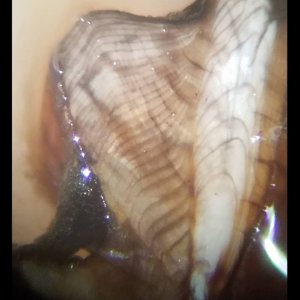[h=6]North Dakota Game and Fish Department[/h]

We have a new old-age standard in walleye caught by fisheries biologists from Lake Sakakawea. Fisheries biologist Russ Kinzler aged a 25.2 inch walleye that was collected in July during the Department's adult sampling. This walleye was 27 years old beating the record set last year of 24 years old. Russ says that he knows of some walleye taken in the Missouri River System in Montana of the same age, but none older.
Bony fish are aged by counting the growth rings on their otoliths (ear bones). Here is an otolith from the 27-year-old walleye.
-----------------------------------------
Additional Information - The 27 year old walleye is a record age, so it isn’t really indicative of the overall population. However, old fish do provide some helpful insight into a fish population. We annually age fish on Lake Sakakawea and find fish of all ages up to the low 20 year range. The previous record was 24 (we also aged 2 walleye at 23 and 24 years old this year). Average age in a population isn’t really a very helpful statistic as it can be dramatically influenced by one or two very strong year classes.
Walleye abundance in Lake Sakakawea is currently the highest it has been since Garrison Dam was closed in 1953, and the population contains a high abundance of fish of all ages and sizes. We have had numerous strong year classes since 2010. and they have driven the population abundance upward pretty dramatically. The presence of very old fish in a system does tell us one thing ----- that overall mortality (including natural and angling) is very low in Sakakawea. On Lake Sakakawea we do have some very old fish as part of the population as well as many younger year classes.

We have a new old-age standard in walleye caught by fisheries biologists from Lake Sakakawea. Fisheries biologist Russ Kinzler aged a 25.2 inch walleye that was collected in July during the Department's adult sampling. This walleye was 27 years old beating the record set last year of 24 years old. Russ says that he knows of some walleye taken in the Missouri River System in Montana of the same age, but none older.
Bony fish are aged by counting the growth rings on their otoliths (ear bones). Here is an otolith from the 27-year-old walleye.
-----------------------------------------
Additional Information - The 27 year old walleye is a record age, so it isn’t really indicative of the overall population. However, old fish do provide some helpful insight into a fish population. We annually age fish on Lake Sakakawea and find fish of all ages up to the low 20 year range. The previous record was 24 (we also aged 2 walleye at 23 and 24 years old this year). Average age in a population isn’t really a very helpful statistic as it can be dramatically influenced by one or two very strong year classes.
Walleye abundance in Lake Sakakawea is currently the highest it has been since Garrison Dam was closed in 1953, and the population contains a high abundance of fish of all ages and sizes. We have had numerous strong year classes since 2010. and they have driven the population abundance upward pretty dramatically. The presence of very old fish in a system does tell us one thing ----- that overall mortality (including natural and angling) is very low in Sakakawea. On Lake Sakakawea we do have some very old fish as part of the population as well as many younger year classes.
